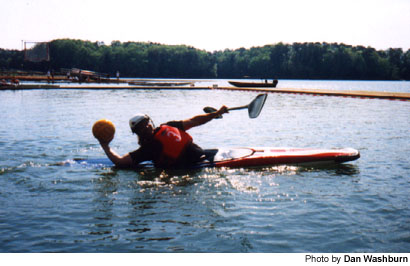
April 27, 1999 — It sounded easy enough.
Paddle kayak over to little yellow ball. Pick up ball. Throw ball in goal.
Yes, it sounded easy enough. But there was one small catch — for me, at least.
“Usually, polo requires that you know how to paddle already,” smiled my kayak polo instructor, Brad Carr, after I informed him that my body had never before seen the inside of a kayak.
OK, maybe it wasn’t such a small catch after all. But I was pressed for time.
Carr was only scheduled to be in Gainesville a few days — for the first-ever U.S. Kayak Polo Championships, held Friday and Saturday at Clark’s Bridge Park — so I was just going to have to learn two things at once.
“We’re probably not going to put you in a skirt then,” said Carr, referring to the piece of neoprene kayakers wear around their waists to seal off the cockpit. “Usually you’d wear a skirt to keep the water out, but beginners sometimes feel trapped.”
I’m sure many of you are surprised to learn that kayak polo’s national championships were held in Gainesville last week.
I’m sure even more of you are surprised to learn that such a sport actually exists in the United States.
Well, it’s likely neither would be true if it weren’t for Carr.
The 32-year-old was first introduced to kayak polo (also known as canoe polo) five years ago while working at the University of Saskatchewan in Western Canada. He’s been playing the sport ever since.
And when Carr took a job in Oak Ridge, Tenn., a year later, he took it upon himself to grow kayak polo in the U.S., a task that required quite a bit of cultivation.
“As an organized sport in the U.S., we’re pretty new,” said Carr, chairman of the U.S. Canoe Polo Committee. “But it’s a pretty big sport worldwide … well … the Western Hemisphere and most of the African continent are pretty void.”
Thanks to Carr’s efforts, part of that void is starting to slowly fill in. Last year he assembled the first-ever U.S. national teams that competed in the Canoe Polo World Championships in Portugal. This past weekend’s national championships are set to become an annual event. And the USCPC will play host to its first international tournament later this year in California.
“We definitely are growing,” said Carr.
With growth, however, comes growing pains. In Portugal, the U.S. men placed 19th out of 20 teams. The women’s team, 11th out of 11.
Teams from countries like Great Britain and Australia, where kayak polo has been played for nearly a quarter of a century, dominate the sport. It’s big in Europe, where kayak polo leagues are a common phenomenon.
Most polo players on the U.S. teams come from a whitewater kayaking background.
“We come from all different professions, from all over the country,” said Carr, himself a Ph.D. geophysicist at the Oak Ridge National Lab. “But we all have two things in common: We are kayakers and we are committed.”
They have to be. Kayak polo players don’t attract multi-million dollar endorsement deals. Not yet, anyway.
Thus, when national team players travel to training sessions, tournaments or monthlong tours, they do so out of their own pockets, often taking leave from work without pay.
So what is this sport that commands such dedication from its participants? What is kayak polo?
“Basically, the game is sort of a cross between basketball, soccer and water polo,” explained Carr, assuming the fact that the sport is played from kayaks is inferred.
Defending raised goals at either end of an approximately 100-by-66-foot pitch of water, two teams of five use their hands and paddles to control the ball and work for an open shot — all the while trying to avoid the opposition’s pushes and shoves.
Pushes and shoves were not included in my lesson. And that was good because early on I was having enough trouble trying to paddle over to that little yellow ball.
It always seemed to stay just out of my reach. I circled it and circled it, but the ball always seemed to drift the wrong way.
Not surprisingly, Carr never encountered such problems. With ease, he tapped the top of the ball with his paddle and scooped it up with his blade. The ball balanced there, until he tossed it over his head and caught it with the paddle’s other blade.
He then flicked the ball forward, paddled up to it and flicked it ahead again. This method of advancing the ball, either with paddle or hand, is kayak polo’s version of dribbling. Carr always seemed to be in total control.
And then he would pass the ball to me.
Now, since I wasn’t wearing a skirt, I found it easiest to place the ball on my lap as I paddled — which is very illegal. In regulation polo games, kayakers have five seconds with which to do something with the ball.
We tossed the ball around for about an hour. I got to the point where I felt somewhat comfortable handling the boat, the ball. I got to the point where I no longer felt the need to place the ball on my lap.
Which was good. Because my lap was now covered with water.
I was sinking.
